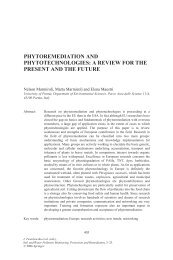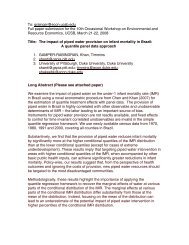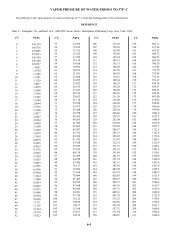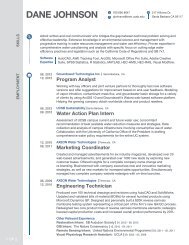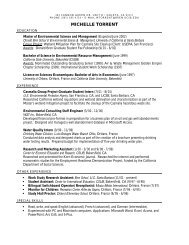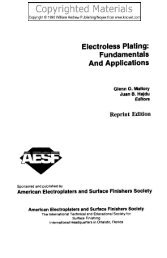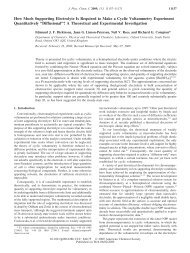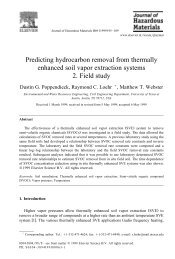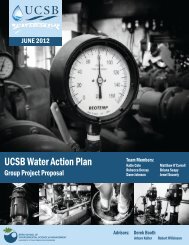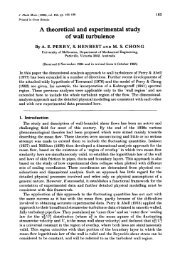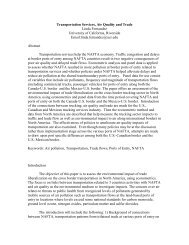anaerobic dehalogenation of halogenated organic compounds
anaerobic dehalogenation of halogenated organic compounds
anaerobic dehalogenation of halogenated organic compounds
Create successful ePaper yourself
Turn your PDF publications into a flip-book with our unique Google optimized e-Paper software.
518 Max M. Häggblom et al.<br />
Albrecht, I.D., Barkovskii, A.L., and Adriaens, P., 1999, Production and dechlorination <strong>of</strong><br />
2,3,7,8-tetrachlorodibenzo-p-dioxin in historically-contaminated estuarine sediments,<br />
Environ. Sci. Technol. 33:737–744.<br />
Alder, A.C., Häggblom, M.M., Oppenheimer, S.R., and Young, L.Y., 1993, Reductive<br />
dechlorination <strong>of</strong> polychlorinated biphenyls in freshwater and marine sediments, Environ.<br />
Sci. Technol. 27:530–538.<br />
Bedard, D.L., 2003, Polychlorinated biphenyls in aquatic sediments: environmental fate and<br />
outlook for biological treatments, In: Dehalogenation: Microbial Processes and<br />
Environmental Applications, M.M. Häggblom and I.D. Bossert, eds, Kluwer Academic<br />
Publishers, Boston, pp. 443–465.<br />
Bedard, D.L., Van Dort, H., and DeWeerd, K.A., 1998, Brominated biphenyls prime<br />
extensive microbial reductive <strong>dehalogenation</strong> <strong>of</strong> Aroclor 1260 in Housatonic River<br />
sediment, Appl Environ Microbiol 64:1786–1795.<br />
Beurskens, J.E.M., Toussaint, M., de Wolf, J., van der Steen, J.M.D., Slot, P.C.,<br />
Commandeur, L.C.M., and Parsons, J.R., 1995, Dehalogenation <strong>of</strong> chlorinated dioxins by<br />
an <strong>anaerobic</strong> microbial consortium from sediment, Environ. Toxicol. Chem. 14:939–943.<br />
Boyle, A.W., Knight, V.K., Häggblom, M.M., and Young, L.Y., 1999a, Transformation <strong>of</strong><br />
2,4-dichlorophenoxyacetic acid in four different marine and estuarine sediments: effects <strong>of</strong><br />
sulfate, hydrogen and acetate on <strong>dehalogenation</strong> and side chain cleavage, FEMS<br />
Microbiol. Ecol. 29:105–113.<br />
Boyle, A.W., Häggblom, M.M., and Young, L.Y., 1999b, Dehalogenation <strong>of</strong> lindane (hexachlorocyclohexane)<br />
by <strong>anaerobic</strong> bacteria from marine sediments and by sulfatereducing<br />
bacteria, FEMS Microbiol. Ecol. 29:379–387.<br />
Boyle, A.W., Phelps, C.D., and Young, L.Y., 1999c, Isolation from estuarine sediments <strong>of</strong> a<br />
Desulfovibrio strain which can grow on lactate coupled to the reductive <strong>dehalogenation</strong> <strong>of</strong><br />
2,4,6-tribromophenol, Appl. Environ. Microbiol. 65:1133–1140.<br />
Bossert, I.D., Häggblom, M.M., and Young, L.Y., 2003 Microbial ecology <strong>of</strong> <strong>dehalogenation</strong>,<br />
In: Dehalogenation: Microbial Processes and Environmental Applications, M.M.<br />
Häggblom and I.D. Bossert, eds, Kluwer Academic Publishers, Boston, pp. 33–52.<br />
Bunge, M., Adrian, L., Kraus, A., Opel, M., Lorenz, W.G., Andreesen, J.R., Görisch, H., and<br />
Lechner, U., 2003 Reductive <strong>dehalogenation</strong> <strong>of</strong> chlorinated dioxins by an <strong>anaerobic</strong><br />
bacterium, Nature 421:357–360.<br />
Cho, Y.-C., Ostr<strong>of</strong>sky, E.B., Sokol, R.C., Frohnhoefer, R.C., and Rhee, G.-Y., 2002,<br />
Enhancement <strong>of</strong> microbial PCB dechlorination by chlorobenzoates, chlorophenols and<br />
chlorobenzenes, FEMS Microbiol. Ecol. 42:51–58.<br />
Cutter, L.A., Watts, J.E.M., Sowers, K.R., and May, H.D., 2001, Identification <strong>of</strong> a bacterium<br />
that links its growth to the reductively dechlorination <strong>of</strong> 2,3,5,6-chlorobiphenyl, Environ.<br />
Microbiol. 3: 699–709.<br />
DeWeerd, K.A., Concannon, F., and Suflita, J.M., 1991. Relationship between hydrogen<br />
consumption, <strong>dehalogenation</strong>, and the reduction <strong>of</strong> sulfur oxyanions by Desulfomonile<br />
tiedjei, Appl. Environ. Microbiol. 57:1929–1934.<br />
DeWeerd, K.A., and Bedard, D.L., 1999, Use <strong>of</strong> <strong>halogenated</strong> benzoates and other <strong>halogenated</strong><br />
aromatic <strong>compounds</strong> to stimulate the microbial dechlorination <strong>of</strong> PCBs, Environ. Sci.<br />
Technol. 33:2057–2063.<br />
Fennell, D.E., Gossett, J.M., and Zinder, S.H., 1997, Comparison <strong>of</strong> butyric acid, ethanol,<br />
lactic acid, and propionic acid as hydrogen donors for the reductive dechlorination <strong>of</strong><br />
tetrachloroethene, Environ. Sci. Technol. 31:918–926.<br />
Fennell, D.E., and Gossett, J.M., 1998, Modeling the production <strong>of</strong> and competition for<br />
hydrogen in a dechlorinating culture, Environ. Sci. Technol. 32:2450–2460.



